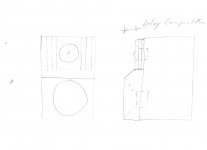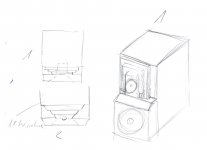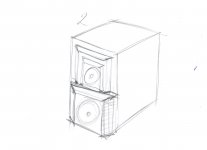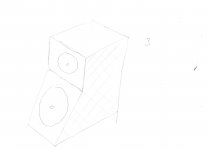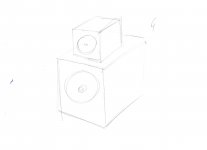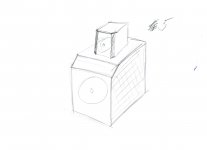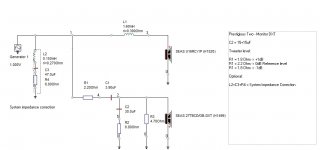Here is my design for an easy to make cabinet that looks good and does the Job as well.
The baffle is staggered and allows delay compensation between the tweeter and the woofer. Diffraction is scattered so the cabinet has less influence on imaging clues. The second version has chamfered edges and should work even better. The edges can also be rounded.
The baffle is staggered and allows delay compensation between the tweeter and the woofer. Diffraction is scattered so the cabinet has less influence on imaging clues. The second version has chamfered edges and should work even better. The edges can also be rounded.
Attachments
Here is my design for an easy to make cabinet that looks good and does the Job as well.
The baffle is staggered and allows delay compensation between the tweeter and the woofer. Diffraction is scattered so the cabinet has less influence on imaging clues. The second version has chamfered edges and should work even better. The edges can also be rounded.
Hi Joachim,
Haven’t you considered using a ”ladder delay network” to electrically address the driver units relative acoustic center off-set instead of using a stepped or slanted baffle?
This would make the loudspeaker enclosure even easier to build, but at the expense of a bit more complicated cross-over design. Sonically it work very well and it’s very easy to fine tune once you have the basic ladder circuit in place.
I’ve found it to work very well when using shallow filters like a true LR2, but it’s over-kill/not necessary to use it with steeper filters.
Here's an example:
Sequence Two – Monitor
Sequence Two – Monitor BE
Regards
/Göran
Sure, really deep bass you feel in your body...
Isn't actually that deep, for an average person, body resonance is around 70-120Hz.
What you call a "ladder delay network" has not only the effect of delaying the tweeter but it also adds an all pass term so you can not build a time coherent speaker with a ladder network. When i go the the Sequence Two measurements the drivers match in phase only over a quite narrow range. With acoustic delay by mechanical means i can do better WHEN i want to make an all pass crossover.
Henry, please show me the Sonus faber model that looks similar.
Tinitus, a thin baffle is not a very stable playground for the drivers.
Henry, please show me the Sonus faber model that looks similar.
Tinitus, a thin baffle is not a very stable playground for the drivers.
here you go
An externally hosted image should be here but it was not working when we last tested it.
Yes, that looks very similar. Is that an old Guarneri ? And yes, why not doing it the same way ? I think it looks good and is effective.
Here are some other ideas. Two of them are modular.
Here are some other ideas. Two of them are modular.
Attachments
Tinitus, a thin baffle is not a very stable playground for the drivers.
I did not suggest thin either
but considering the very small and close to non existent area you have around a 6" driver on the inside, well.....
as long as the front baffle is sturdy material like plywood, the exstra effort is much better spent on making the rest of the enclosure thick, in my opinion
Design number 1 can also be modified by putting felt around the staggered elements making the tweeter baffle flat in essence.
Or do the trick all the car stereo guys do. Stable fleece across it and pour on the resin. Back fill with expanding foam.
What you call a "ladder delay network" has not only the effect of delaying the tweeter but it also adds an all pass term so you can not build a time coherent speaker with a ladder network. When i go the the Sequence Two measurements the drivers match in phase only over a quite narrow range. With acoustic delay by mechanical means i can do better WHEN i want to make an all pass crossover.
“Ladder Delay Network” filter, “All-pass Network”, “Lattice Network” or “Phase Control Circuit”, different names for the same thing.
I thought one of the design goals was a simple to build enclosure? What could be easier to build than a flat baffle?
If using a flat baffle together with shallow sloped filter the way to go is a tweeter delay circuit or a tweeter waveguide or horn to get a “time coherent” loudspeaker. Another way to do it would be to time delay the tweeter actively.
Time delaying the tweeter mechanically also works fine, but could give other issues like diffraction. The enclosure design 4 and 5 could be problematic regarding diffraction and enclosure build complexity.
My suggestion of a “time delay circuit” was just a humble question if it was something you had consider as an option. Clearly you have decided to go with the “mechanical” way and that’s great and I do like the stepped baffle better than the slanted way.
Most published designs I’ve read never shows the individual drivers phase tracking. I choose to publish mine, but I don’t think it should be over over-interpreted. Some people even argue that phase distortion can’t be heard as long as the frequency response is reasonably flat.
I agree that my phase tracking is only perfect one octave below and above the cross-over frequency and then slowly deteriorates. I realize that you haven’t decided the cross-over topology yet, but considering enclosure design I guess you are going for a shallow sloped topology? You as a very experienced designer, how wide do you consider a good phase tracking should be in the Satori Monitor design?
Unfortunately most published DIY designs I’ve read from loudspeaker driver manufacturer’s only shows impedance and on-axis response. Sometimes they show reverse polarity response and individual driver on-axis frequency response. This is simply not enough to technically evaluate a design. With that said, measurements alone don’t tell if a loudspeaker sounds good or not. Often when doing the final adjustments and voicing of a loudspeaker design, changes are made that measurement wise isn’t perfect, but actually do sounds better.
This could be one of the reasons why many published DIY designs doesn’t show any detailed measurements or just because they doesn’t want scare off people with a less good design. If you look at commercial designs we almost never see any measurements to back up the design, but instead a lot of marketing mumbo jumbo.
I really hope the fully documented design will contain on and off-axis frequency measurements, both horizontally and vertically as well as individual drivers phase tracking, impedance and distortion measurements.
I’ve been interested in the Satori MW16 for some time now and I think this thread is very interesting and I hope you share us your measurements and listening impressions of the Satoris.
I will follow this build thread with great interest.
Regards
/Göran
I decided on mechanical delay compensation because i would like to have as much options as possible and the all pass ladder does simply not allow to make a phase coherent speaker that i would also like to try. You know that of cause. Also it is against my philosophy of using as few components as possible.
If a L/R4 has enough phase distortion to be audible is not so easy to answer. Simply comparing it to a first order design will not work because both version have totally different off axis responses with the first oder lobing but with a flat power response overall whereas the L/R is more symmetrical but with a 3dB hole in the power response around the crossover frequency. Yes, of cause, i measure off axis since ages and will publish all relevant data. If i do the data collection right can be debated though.
In Germany we say " Wer viel misst misst Mist"
If a L/R4 has enough phase distortion to be audible is not so easy to answer. Simply comparing it to a first order design will not work because both version have totally different off axis responses with the first oder lobing but with a flat power response overall whereas the L/R is more symmetrical but with a 3dB hole in the power response around the crossover frequency. Yes, of cause, i measure off axis since ages and will publish all relevant data. If i do the data collection right can be debated though.
In Germany we say " Wer viel misst misst Mist"
"Wer viel misst misst Mist".
Ja, ich stimme Ihnen völlig zu!
Also it is against my philosophy of using as few components as possible.
Yes, exactly my philosophy also.
This is an example of a very simple cross-over using a true LR2 cross-over, without any delay circuit or sloped/stepped baffle.
Prestigious Two – Monitor DXT
Less is more!
Great website that you host, i went over it some time ago but not in detail. I will do that soon.
Thank you!
I just wish I was a better writer. I have so much I want to write about, but it's hard especially when its not in your native language.
Regards
/Göran
Attachments
The SEAS DXT is somewhat set back because of the special waveguide. That helps.
It is a good tweeter when you get the falling response under control. Does not have much issues with edge diffraction too. Commercially it does seem that it is not that successful. Maybe people are just looking at the raw response and that does not look flat.
I did a lot of speakers with a flat baffle that sounded nice and by playing around with non textbook crossovers i got a rather flat response with good radiation pattern.
If that is the wish, i can do that fast and easy. Then we have an entry level design that can be build by virtually everyone that doe snot have two left thumbs.
It is a good tweeter when you get the falling response under control. Does not have much issues with edge diffraction too. Commercially it does seem that it is not that successful. Maybe people are just looking at the raw response and that does not look flat.
I did a lot of speakers with a flat baffle that sounded nice and by playing around with non textbook crossovers i got a rather flat response with good radiation pattern.
If that is the wish, i can do that fast and easy. Then we have an entry level design that can be build by virtually everyone that doe snot have two left thumbs.
- Home
- Vendor's Bazaar
- SB Acoustics Satori Monitor
